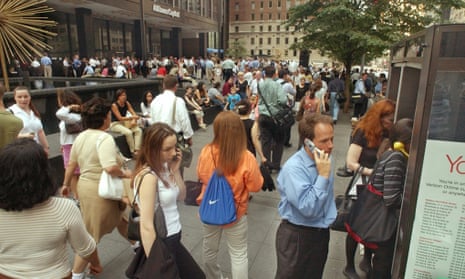The goal of free, high-speed internet for everyone in New York City has jumped much closer: Sidewalk Labs, the new Google-backed startup that was created last month to improve city life though technological innovation, has announced it is investing in a project to turn the city’s payphones into Wi-Fi hotspots.
The company is among a group of investors acquiring two New York-based firms that have been leading the effort to turn disused payphones into 10,000 Wi-Fi hotspots and information kiosks, beginning later this year. In a stroke, it puts Sidewalk Labs – and, by proxy, Google – in the lead of the world’s highest-profile rollout of free, citywide Wi-Fi.
The project, LinkNYC, was the winning entry in the Reinvent Payphones Design Challenge, a competition that solicited innovative ideas for reusing some of the city’s roughly 11,000 public payphones. The service contracts for those phones expired in 2014, and LinkNYC – which launched in November 2014 – envisioned converting the disused phone booths into 21st-century information portals. They would provide free Wi-Fi to a radius of up to 150ft, mobile device chargers, and an interactive screen that would itself offer internet access, free nationwide phone calls and access to local services and information.
The kiosks will also hold large digital advertisement screens, which will pay for the project and augment the city’s coffers.
“By integrating new technologies into existing infrastructure, cities can reinvent these assets – providing not just more modern, free services to citizens but even more revenue to cities,” said Sidewalk Labs CEO Dan Doctoroff, who previously served as a deputy mayor of New York from 2001 to 2008.
Sidewalk Labs was launched earlier this month, with money from Google and a broad mandate to foster urban innovation. The goal, according to Google CEO Larry Page’s announcement, is to develop and grow civic technologies that can reduce the cost of living, make transportation more efficient and reduce overall energy usage. He’s likened Sidewalk Labs to Google X, the lab within the company focusing on so-called “moonshot” projects like autonomous cars and a network of internet-connected balloons that can provide service to far-flung areas.
As the concept of the tech-enabled smart city edges closer to reality, Google sees opportunity to apply its technological expertise to the complex and often interrelated issues of the city – and to make some money along the way. In Doctoroff, Google has an experienced businessman and city official who helped enable New York’s popular and successful High Line park and led its ultimately failed bid to host the 2012 Summer Olympics. Fancy parks and mega-events, however, don’t rank highly on the list of day-to-day concerns in the world’s growing cities. As Page put it, the general purview of Sidewalk Labs is to find technological solutions to “help transform cities to be more livable, flexible and vibrant”.
Until the recent announcement, it was unclear what Google’s new focus on cities might mean. But – by taking a small stake in Control Group, the company providing the interfaces for LinkNYC’s kiosks, and Titan, which helps run the advertising side – Sidewalk Labs has shown it is interested in finding existing projects and speeding them up. The two firms will merge into a new company, Intersection, with Doctoroff as chairman. Again, exactly what that means – and how much influence Sidewalk Labs and Google will have – is unclear. Neither Sidewalk Labs nor Intersection representatives were available to comment.
With 10,000 kiosks being converted over the next 12 years, the LinkNYC project is estimated to cost about $200m. CityBridge, the partnership of companies that will build, install and operate the kiosks, estimates that advertising will generate at least $500m in revenue for the city over that 12-year period, roughly half of the project’s anticipated gross revenue.
New York is only the beginning: Sidewalk Labs envisions spreading this concept to other cities. The model is scalable, according to company officials. And Intersection says it will help other cities update ageing infrastructure, such as old street lights and bus shelters, to “create a cohesive network of dynamic messaging across these assets” – including emergency notifications, real-time transit information and wayfinding.
Making such information widely accessible alongside advertisements aligns neatly with Google’s main strengths – indexing the internet and serving ads – so it’s not hard to see why the company, through Sidewalk Labs, would be investing in this realm. For its part, Sidewalk Labs claims to be less interested in Google’s ad business and more focused on exploring how technology can be used to change the ways people experience and interact with cities, and to make them “more efficient, responsive, flexible and resilient”.

Comments (…)
Sign in or create your Guardian account to join the discussion